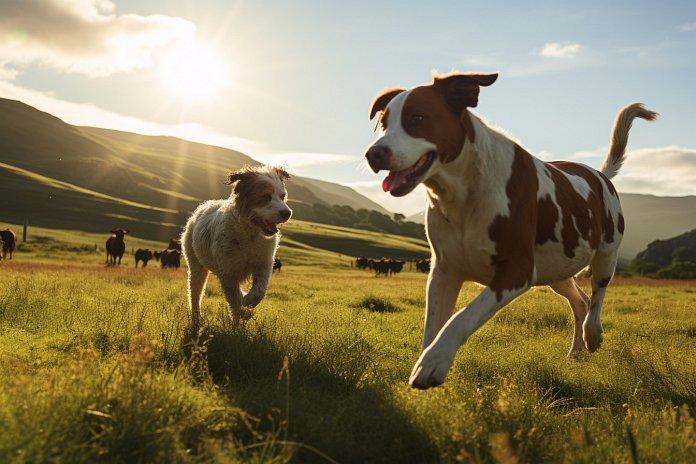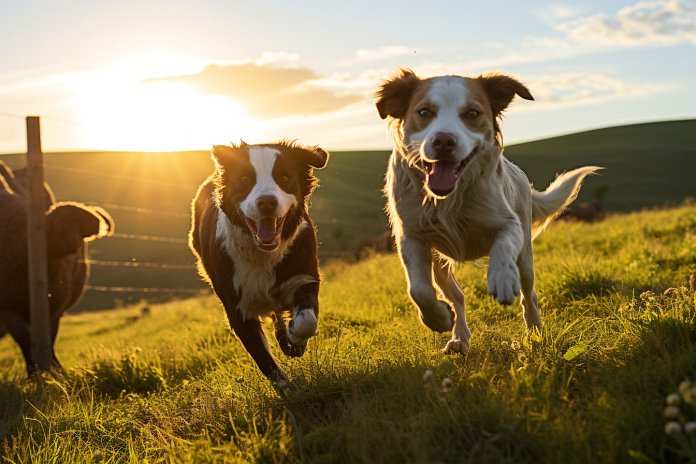
We love our dogs as our best friends. On a farm, a dog is a great helper to the farmer, guarding livestock, herding cows, and providing companionship.
If you have cows on your farm, you may find that cows can be just as fun and affectionate as dogs. Cows can be playful, enjoy being petted, snuggle, learn tricks, and even give kisses!
However, both cows and dogs have instinctive responses to stimuli and other animals. Cows are large and can be aggressive, so it’s important to take steps to ensure the safety and harmony between your dog and the cows.
Signs of a Dog Being Friendly With a Cow
There are many stories of cows and dogs living together peacefully. Look for signs that the relationship between your dog and the cow is going well. Cows will lick animals they like, so if your dog is getting cow kisses, that’s a positive sign. Your dog may also be playful and comfortable around the cow, engaging in activities like romping or snuggling.
Friendly behaviors from your dog include wagging his tail and being attentive to commands and behaviors from you and the cows. Barking can be a sign of your dog doing his job, but it can also indicate stress, so be aware of the context.
Creating a Harmonious Relationship
When dogs and cows live together, they will have their own spaces for sleeping, eating, and exercising. Your dog may find safe spots near the cow where he can be close without getting hurt. It’s important to be aware of your dog’s instincts around calves, as he may exhibit predatory behaviors.
Body Language
There are signs that indicate a good relationship between your dog and the cows, such as alertness, barking, head tilting, listening, tail wagging, and raised ears. Other signs include seeking closeness to the cow, following cow routines, playing and resting together.
The History and Science of Dogs Living With Cows
Dogs have been domesticated by humans for over 15,000 years, initially for survival needs and hunting. As farming developed, dogs played a role in managing livestock. Different dog breeds have evolved for specific farm jobs, such as herding or guarding. Dogs have adapted to living on farms, with biological and behavioral factors contributing to their ability to coexist with cows.
Training Dogs to Live With Cows
Training is crucial to ensure the safety and harmony of dogs and cows. Introduce them gradually, allowing them to get used to each other’s smells and increasing their proximity over time. Teaching your dog commands like come, stay, drop it, leave it, down, go to mat, sit, leash manners, crate, and quiet will help keep everyone safe and under control.
Keeping Your Dog Safe Around Cows
Never leave your dog unsupervised around cows. Train your dog to respond to your commands and to rest in a designated safe place. Understand the disposition and dominance of the cow to prevent any harm to your dog.
“Training and supervision are key to fostering a harmonious relationship between dogs and cows on the farm.”

Tips & Things to Know
1️⃣ Be aware of the signs of a positive relationship between your dog and the cows, such as cow kisses and playful behavior. This indicates that they are getting along well and have formed a friendly bond.
2️⃣ Pay attention to your dog’s body language and behaviors when around cows. Signs like barking, head tilting, and wagging tail can indicate their level of comfort and excitement. However, be cautious of barking that is not work-related, as it may indicate stress and can disturb the cows.
3️⃣ Train your dog to live harmoniously with cows by starting at a young age and gradually introducing them to each other. Use positive reinforcement and teach them essential commands like “come,” “stay,” and “leave it.” This will help ensure their safety and the peaceful coexistence of both animals.
Frequently Asked Questions, Answered ✅
1. How can you tell if a dog and cow have a positive relationship?
– Signs of a positive relationship include cow kisses, playful behavior, and being at ease around each other.
2. What are some signs that a dog is stressed around cows?
– Barking when not on the job and exhibiting behaviors like dropped ears, growling, staring, or jumping can indicate stress.
3. Which dog breeds are most likely to attach to cows as pack members?
– Anatolian Shepherd, Komondor, Maremma, and Tibetan Mastiff are breeds that are likely to attach to cows.
4. Why are dogs adaptive to living on a farm?
– Dogs have evolved to digest starch and have developed a biological advantage to living on farms.
5. What are some important commands to train a dog when living with cows?
– Some important commands include come, stay, drop it, leave it, down, go to mat, sit, leash manners, crate, and quiet.